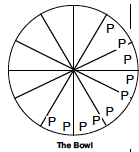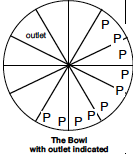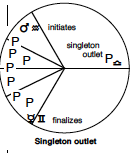by Marilyn Muir, LPMAFA

This work is licensed under a Creative Commons Attribution-NonCommercial-ShareAlike 4.0 International License.
What happens when you take a handful of planets… ten… and toss them against a wall… space… then look at their overall scattering or clustering? What can it tell you about the individual? I use this reading tool as the first step in every natal reading I do, and its application is not limited to the natal chart. The progressing chart has the capacity to temporarily change the chart pattern particularly through the action of the progressing moon. For the purposes of this application, only the ten bodies are used. Do not use any of the hundreds, perhaps thousands of possible points in a chart other than the ten primary bodies. Additionally, the positions in the chart by house have no bearing on the choice of pattern. There are really only two rigid rules:
- Rule #1: count 10 planets only.
- Rule #2: Count by signs, not by houses. The farther the latitude of birth is from the equator, the more distorted the house system becomes and houses increase and decrease in size dramatically. You will make mistakes counting by houses, so be sure to use signs.
Each of us has an individual way of involving ourselves in, or responding to, life and experience. Understanding that personal approach shows us the overall organizing drive (or lack of it) of the individual as life’s experiences are encountered. For some, that application is conscious; for others, it is unconscious.
Chart patterns originated with Mark Edmund Jones. His book The Guide to Horoscope Interpretation should be your beginning point for study. Every other author/group started there. Standard astrological work generally follows the Jones divisions. I make one exception. First, I will describe the seven patterns and then explain my single exception. Note: For this section, direct quotes are taken from my first book, Astrology: The Symbolic Language. Personal approaches range from focused and specifically directed to widespread, encompassing, even scattered. For this system, the seven basic approaches to life are the Bundle, Bowl, Locomotive, Bucket, See Saw, Splay and Splash.
Six of the seven groupings have specific shapes that suggest the names of the patterns themselves. The seventh grouping suggests randomness, showing little or no specific shape. The patterns have ideal facets but experience will show you that many charts do not fall into the “ideal mold.” For much of the time it is not difficult to determine the pattern. Sometimes the pattern is in the process of shifting, it overlaps, is not ideal or clear, or requires the toss of a coin or the personal choice of the reader. At that point, choices for me fall into the concept of a “process of elimination” or the “best choice” out of several possibilities.
Remember too, that energy and direction can have both positive and negative applications. Each of these chart patterns will have a positive quality and a negative quality as every coin of experience has a front and a back, the visible and the flip side. Positive qualities support the individual and their experience. Negative qualities undermine the individual and their experience. To some degree, choice and personal perspective determines the positive or negative application. None of the patterns are better or worse, they just are. Our use of them determines the outcome.
When really difficult to discern, the individual may flow in and out of a close choice, perhaps alternating; perhaps early experience one expression and later experience another. Again, the progressing chart has the capacity of temporarily changing the chart pattern particularly through the action of the progressing moon. That means the thrust of the energy itself changes, and that applies through the life of the individual as changed possibilities. Read all legitimate choices and explain the positives and negatives of each. Encourage the client to reach out into the positives and to be vigilant for the principle that “every front has a back.” Life is not rigid, nor does it allow for one application only. A negative can be turned into a positive, or a possibility into a reality. It is really our choice.
Bundle: The tightest division is a clustered grouping of all ten bodies, ideally within 120˚, four signs of space or 1/3 of the wheel leaving 2/3rds of the wheel or 240˚ empty. This is a tightly focused individual, interested in certain functions or areas of life, who largely ignores whatever is represented by the 240˚ of empty space. The possibilities of the ten planets function within a limited segment of life represented by the houses. Negatively, the disinterest of the individual for large segments of life can be experienced as blind spots. The approach is one pointed, narrow, which can lead to a naturally built-in blind spot. A good metaphor is the “horse with blinders on”. The unexplored or unacknowledged large segment occasionally batters the individual. The natural focus is good; a blind spot is not good.
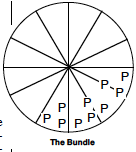
Bowl: All ten bodies are clustered within half or180º of the chart, regardless of house placements, and are ideally contained within an opposition. Borderline: If you encounter a chart whose planets are clustered more than 120˚ but less than 180˚, you must turn to the rim planets to determine their direct or retrograde motion to determine the pattern’s past and future possibilities. The past is where a planet has been. The future is where a planet is going.
Not as focused as the Bundle, the Bowl is a pattern of potential, 50% of life experience is occupied, 50% is not. The individual develops itself within the occupied portion of the chart, but is fully aware of what is lacking in the empty portion of the chart. This can be quite frustrating. This chart needs the catalyst of the opposition to occasionally break through and allow potential to become actuality; or if no real opposition, activation must be by transit, progression or direction.
My analogy is a child’s game of leapfrog, with lots of preparation and an occasional leap, precipitated by a catalyst. One child crouches and another child leaps over their back, then they reverse positions and repeat the leap. 90% preparation, 10% leap… the life and experience of the individual with a bowl chart. This is great for the developing of potential but it is more difficult to actualize that potential. Another definition could be “self-contained”. The point opposite the center of the bowl grouping can imply an outlet point even though there is no body located there.
Bucket: Ideally, nine of the planets are clustered into one grouping within 180˚, with one planet in the empty portion of the chart, isolated from the others, preferable directly opposite the center of the grouping as a “handle”. A two-planet conjunction is allowed if within 10’ of perfect according to MEJ.
I prefer the analogy of the familiar kitchen funnel, with a wide portion terminating in a single, focused outlet. That focus can have a strong sense of destiny or need to accomplish a specific task, either chosen or experienced. The ideal funnel has the spout directly in the center. The collection of energy represented by nine planets is blended and focused through a single outlet represented by the singleton planet.
At times that spout or outlet is directly opposed the center of the cluster. At other times the spout of the funnel is off-center, suggesting specialty application such as an off-sided funnel used to put motor oil in a car. The ingredients of life are clustered, gathered, mixed and focused, given a specific outlet, for good or ill. My analogy for this pattern, “If you don’t happen to life, life will happen to you.”
Locomotive: The ten bodies are casually spread throughout 240˚ of space, eight signs, with 120˚, four contiguous signs, empty. This is the opposite of the Bundle space-wise, but not necessarily application-wise. There are usually no conjunctions, no clusters in either houses or signs, just a flowing spread to the planets. Ideally, all eight signs will be occupied and all houses will be occupied.
Think of a row of dominos lined up carefully. If you tip the lead domino, the others will cascade into experience. This is the approach and intent of this native. They will get their ducks lined up in a row before they initiate experience. What do you do when you see a locomotive coming? You get out of its way. These natives will mow you down, not necessarily by specific intent, but by their tendency to stay in motion, nothing personal.
What if the pattern is not ideal and there are gaps and breaks in the process? Think of a train track with gaps. A small gap may not derail the train and may only cause trouble. A large gap may cause derailing. Advice to one with gaps: “pick yourself up, dust yourself off, start all over again.” I would amend that statement by adding to start over again from the point of the gap itself. The pattern remains intact.
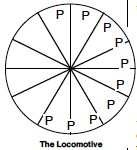
Borderline: The Bundle, Bowl, Bucket or Locomotive are the possibilities of alternate choice. Your determining factor should be whether the natural motion of the outside, rim or containing planets are tightening or loosening the cluster itself. Go with its future motion or intent. What has been is history, separating aspects equal the past. What will be the future is experience itself. Are the rim planets reinforcing the bundle? Are the rim planets attempting to perfect an opposition as in the bowl? Are the rim planets past the opposition and opening into the possibility of a bucket or a locomotive pattern even if it is not ideal? The past can show a habit. The future is determined by new experience.
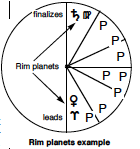
See-Saw: We have all seen or played on a child’s teeter-totter or see-saw. A long board, suspended over a fulcrum or center point; a child or children piled on each side, taking turns as the board swings up and down from the weight, occasionally balancing when the weight is evenly distributed. The chart looks like this… a grouping on one side opposed by a grouping on the other side. The groupings may be even (i.e., 50/50) or uneven (i.e., 60/40, 70/30, 80/20, but never 90/10, which is a Bucket).
Negatively, the individual is torn in opposing directions in life. Energy must be given to two opposing factions or emphasis simultaneously. The individual needs to understand all life and experience will be divided and take charge of that requirement through objective decision. If the individual understands this polarization is probable, they can make accommodation for it. If they are unconscious of this tendency, it can be quite difficult and at times immobilizing. In my experience rim planets do not seem to have much application here.
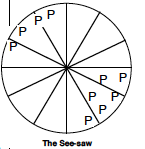
Splay: The ten planets are grouped into three sharp, forceful conjunctions or close proximity, at regular intervals in the chart, roughly 1/3rd of the chart apart, forming a distinct tripod shape. The tripod is a very stable foundation and approach, even more stable than a four-legged stool. Rim planets do not seem to have much application in this pattern as well as they are difficult to distinguish from the six possible choices.
Stability and pragmatism are the earmarks of this pattern. I have encountered this pattern rarely as the owners do not usually come for chart readings. If they do, be sure to compliment them on their open-mindedness. They too have a blind spot in that their focus demands all their attention; social interaction may suffer.
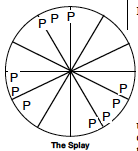
Splash: All ten bodies are distributed randomly around the entire chart, with no specific pattern visible usually with no conjunctions. This native is interested in all experience, which is called an “eclectic outlook”. The native splashes out into life, trying it all, and can become the jack-of-all-trades and the master of none. Discernment or learning to say “no” is the positive solution to this eclectic outlook. I own a Splash pattern myself and you do live through it, but you are very, very busy!
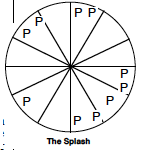
Catch-all category: When it is difficult to determine a pattern, M.E. Jones used the Splay pattern as his catch-all. I take issue with that. The Splay is such a specific pattern and rare to encounter in my experience. I do not see how it can be considered the catch-all category. I instead prefer the Splash as my catch-all category. If I cannot locate a specific pattern with six of them quite specific even when borderline, then to me it is a non-specific or Splash chart.
Along with Mark Edmund Jones’s material, Michael Meyer did chart pattern work in The Astrology of Change. Bil Tierney also did chart pattern work in his Dynamics of Aspect Analysis and Donn and Leone Forrest offered more insights in Astrological Chrestomathy, all books well worth studying. In addition, a website is available by students of MEJ’s work and technique:
The Origin and History of the Sabian Symbols – The Sabian Assembly.
First published on All Things Healing website Jul 2011, republished with slight editing.

This work is licensed under a Creative Commons Attribution-NonCommercial-ShareAlike 4.0 International License.
